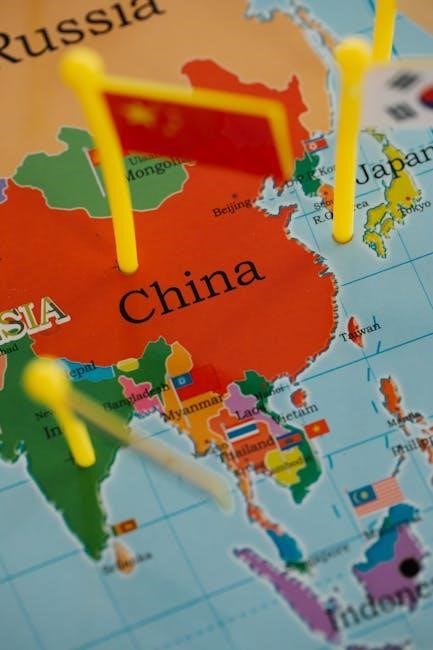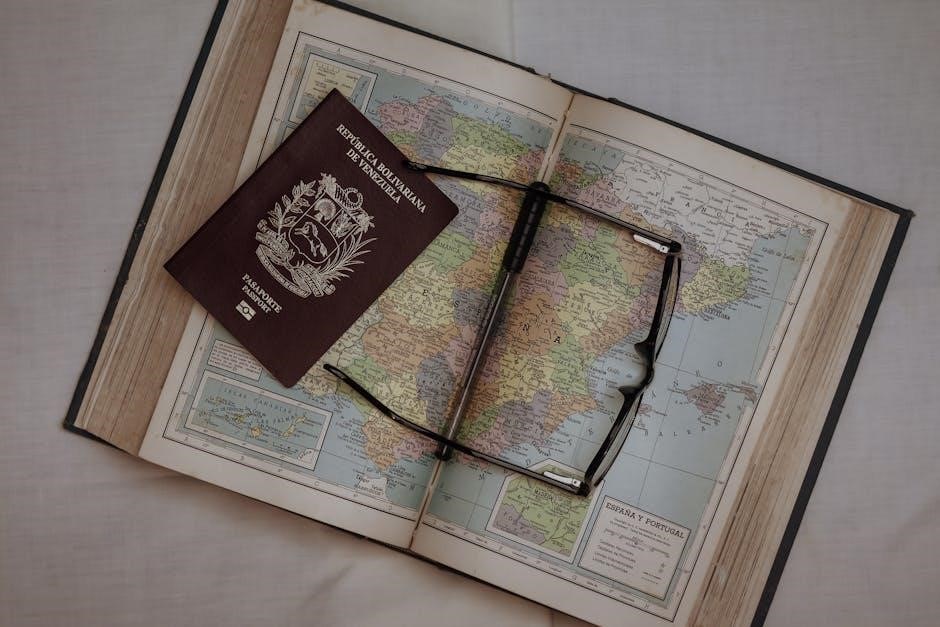Unit 7: Global Warfare ⸺ Study Guide
This comprehensive guide explores global conflicts from 1900 to the present, focusing on shifting power dynamics, technological advancements, and geopolitical changes that shaped modern warfare and international relations.
Global warfare from 1900 to the present has been defined by transformative conflicts, technological advancements, and shifting geopolitical dynamics. This period saw the rise of total war, where entire societies were mobilized, leading to unprecedented human casualties and societal upheaval. The introduction of new weapons, such as machine guns, tanks, and atomic bombs, revolutionized military strategies and amplified the destructiveness of war. Ideological tensions, including the clash between fascism, communism, and democracy, fueled global conflicts like World Wars I and II and the Cold War. These events reshaped national borders, led to the decline of traditional empires, and spurred decolonization. Understanding the causes, conduct, and consequences of these conflicts is crucial for analyzing their impact on modern international relations and global power structures. This study guide provides a detailed exploration of these themes, equipping students with a comprehensive understanding of global warfare in the 20th and 21st centuries.
Historical Context: 1900 to Present
The period from 1900 to the present has been marked by profound global transformations shaped by warfare, political upheavals, and technological advancements. The early 20th century witnessed the decline of traditional empires, such as the Ottoman and Austro-Hungarian Empires, due to internal instability and the devastating impact of World War I. The interwar period saw the rise of fascist and nationalist ideologies, which culminated in World War II, a conflict that reshaped global power dynamics and led to the emergence of the United States and the Soviet Union as superpowers. The Cold War that followed was defined by ideological tensions, proxy wars, and the threat of nuclear annihilation. The latter half of the 20th century also saw decolonization, as nations in Africa, Asia, and the Middle East gained independence from European colonial rule. By the 21st century, global warfare evolved into asymmetric conflicts and terrorism, with technology playing a central role in modern combat strategies.

Shifting Power Dynamics After 1900
Shifting power dynamics after 1900 were driven by the decline of traditional empires and the rise of new global powers, reshaping political, economic, and military landscapes worldwide.
Internal and External Factors
Internal and external factors significantly influenced the shifting power dynamics after 1900. Internally, nations faced challenges such as political instability, economic disparities, and social unrest, which weakened traditional empires. Externally, geopolitical tensions, colonial rivalries, and the rise of new global powers disrupted existing balances. The decline of empires like the Ottoman and Austro-Hungarian was hastened by internal decay and external pressures. Meanwhile, rising powers such as the United States and Japan leveraged industrialization and military expansion to assert dominance. These factors intersected, creating a volatile global landscape that set the stage for conflicts like World Wars I and II. Understanding these internal and external drivers is crucial for analyzing how power shifted during this period and how it reshaped the modern world order.
Decline of Traditional Empires
The decline of traditional empires after 1900 was a pivotal aspect of global warfare. Empires such as the Ottoman, Austro-Hungarian, and Russian faced internal decay, including political instability and economic strain, which weakened their structures. External pressures, like the rise of nationalism and the ambitions of emerging powers, further accelerated their downfall. World War I marked the collapse of several empires, with the Treaty of Versailles redrawing national borders and creating new states. Economic exhaustion from the war and the spread of revolutionary ideologies also contributed to the end of imperial dominance. The decline of these empires reshaped global power structures, leading to the rise of new nations and the formation of international alliances. This transformation set the stage for future conflicts and the reconfiguration of the world order, emphasizing the end of an era dominated by traditional empires.
Rise of New Global Powers
The 20th century witnessed the emergence of new global powers that reshaped international relations and warfare. The United States, the Soviet Union, China, and Japan rose to prominence, challenging the dominance of traditional European empires. Economic growth, industrialization, and military expansion were key drivers of their ascent. The U.S. emerged as a superpower after World War II, while the Soviet Union became its rival during the Cold War. China’s Communist Revolution in 1949 marked its rise, and Japan’s economic miracle post-World War II reestablished it as a global power. These nations leveraged technological advancements, strategic alliances, and ideological influence to project power. The rise of these powers shifted the global balance, leading to new conflicts and alliances. Their emergence also introduced new dimensions to warfare, including ideological proxy wars and the race for nuclear deterrence, fundamentally altering the nature of global conflict and international diplomacy.

Causes, Conduct, and Consequences of Global Conflicts
Examines the origins, strategies, and outcomes of global conflicts, emphasizing how nationalism, imperialism, and ideological tensions fueled wars, while technological advancements and societal changes shaped their execution and aftermath.
World War I: Causes and Key Events
World War I (1914–1918) arose from complex tensions, including nationalism, imperialism, militarism, and the intricate system of alliances. The assassination of Archduke Franz Ferdinand by Serbian nationalists triggered the conflict. Key events included the Battle of the Somme, Verdun, and the introduction of trench warfare, which highlighted the brutal realities of modern combat. The U.S. entered the war in 1917, shifting the balance. The Treaty of Versailles (1919) ended the war but imposed harsh penalties on Germany, fueling resentment and setting the stage for future conflicts. The war’s global impact included massive casualties, economic devastation, and the collapse of empires, reshaping the international order and laying the groundwork for World War II.
World War II: Global Impact and Outcomes
World War II (1939–1945) was the deadliest conflict in human history, involving major powers and reshaping the global order. It began with Germany’s invasion of Poland, escalating into a worldwide conflict. Key events included the Holocaust, the attack on Pearl Harbor, the Battle of Stalingrad, and the D-Day invasion. The war’s outcome was shaped by the Allied victory, leading to the emergence of the United States and the Soviet Union as superpowers. The Holocaust resulted in the genocide of six million Jews and millions of others, highlighting the horrors of totalitarian regimes. The war’s end led to the formation of the United Nations to promote international cooperation. The global impact included widespread destruction, economic upheaval, and the beginning of decolonization. The Yalta and Potsdam Conferences laid the groundwork for the Cold War, while the dropping of atomic bombs on Hiroshima and Nagasaki introduced the nuclear age, forever altering global geopolitics and military strategies;
The Cold War: Ideological Conflicts and Proxy Wars
The Cold War (1947–1991) was a period of intense ideological and geopolitical rivalry primarily between the United States and the Soviet Union. Rooted in conflicting ideologies of capitalism and communism, it avoided direct military confrontation but manifested through proxy wars, espionage, propaganda, and an arms race. Key proxy conflicts included the Korean War, the Vietnam War, and the Cuban Missile Crisis, which brought the world to the brink of nuclear war. The ideological battle also extended to space exploration, with the Space Race symbolizing technological superiority. The Cold War reshaped global alliances, leading to the formation of NATO and the Warsaw Pact. It ended with the collapse of the Soviet Union in 1991, marking the triumph of capitalism and the emergence of the United States as the world’s sole superpower. The Cold War’s legacy continues to influence modern international relations, military strategies, and global security frameworks.

Technological Advancements in Warfare
Technological advancements transformed warfare by introducing new weapons, strategies, and tactics. Innovations like tanks, aircraft, and nuclear weapons revolutionized military capabilities, increasing efficiency and lethality. These developments reshaped global conflicts and societal impacts.
The 20th century saw the introduction of revolutionary weapons and strategies that transformed warfare. World War I introduced machine guns, tanks, and poison gas, which increased battlefield lethality. In World War II, strategic bombing, jet aircraft, and atomic bombs emerged, amplifying destruction. The Cold War brought missile technology and nuclear deterrence, reshaping global conflict dynamics. These innovations forced militaries to adapt tactics, such as trench warfare in WWI and guerrilla warfare during colonial conflicts. The development of new weapons and strategies not only changed how wars were fought but also influenced political and social landscapes. These advancements highlighted the brutal efficiency of modern warfare and its far-reaching consequences for humanity. Understanding these developments is crucial for grasping the evolving nature of global conflicts and their impact on society.
Impact of Total War on Society
Total war, characterized by the mobilization of entire societies, profoundly impacted global communities. During World War I and II, governments utilized propaganda, media, and art to shape public opinion, fostering national unity and support for the war effort. Civilians became direct participants, with women entering the workforce and resources being diverted to military production. The human cost was immense, with millions of casualties and widespread destruction. Total war also led to the displacement of populations and the collapse of economies. The societal effects were long-lasting, influencing political ideologies and social structures. This phenomenon underscored the interconnectedness of warfare and civilian life, highlighting the far-reaching consequences of global conflicts. Understanding the impact of total war is essential for analyzing the social and economic transformations of the 20th century.
Role of Airpower and Naval Warfare
Airpower and naval warfare emerged as pivotal components of global conflicts in the 20th century; Airpower transformed warfare by enabling strategic bombing campaigns, surveillance, and rapid troop deployment. World War I saw the introduction of aircraft for reconnaissance and combat, while World War II highlighted airpower’s decisive role in battles like the Battle of Britain and the atomic bombings of Hiroshima and Nagasaki. Naval warfare also evolved, with submarines and aircraft carriers becoming central to maritime strategies. The dominance of naval fleets ensured control over crucial trade routes and amphibious assaults, such as D-Day. These advancements reshaped military tactics, emphasizing technological superiority and long-range capabilities. The integration of air and naval forces into modern warfare underscored their critical role in securing territorial dominance and influencing global power dynamics. Their impact remains central to contemporary military strategies, reflecting the ongoing evolution of warfare technologies and doctrines.

Geopolitical Changes and Their Effects
Geopolitical changes after 1900 reshaped global power structures, leading to border redraws, decolonization, and new alliances, significantly impacting international relations and global stability.
Redrawing of National Borders
The redrawing of national borders after global conflicts significantly altered the world map, particularly following World Wars I and II. The Treaty of Versailles redrew boundaries in Europe, creating new states and reshaping existing ones. Post-WWI, the collapse of empires like the Ottoman and Austro-Hungarian led to the establishment of smaller, independent nations. Similarly, post-WWII, borders shifted again, with the Soviet Union expanding its influence. Decolonization in the mid-20th century further transformed borders as countries in Africa and Asia gained independence. These changes often led to territorial disputes, ethnic tensions, and, in some cases, long-standing conflicts. The redrawing of borders also influenced global power dynamics, with new nations aligning with emerging superpowers during the Cold War. This reshaping of territories remains a critical factor in understanding modern geopolitical landscapes and international relations.
Decolonization and Its Consequences
Decolonization, primarily occurring in the mid-20th century, marked the transition of colonies to independent nations, reshaping global politics and societies. Post-WWII economic strain on European powers and rising nationalist movements propelled this process. The dismantling of colonial empires led to the emergence of new states in Africa, Asia, and the Caribbean. However, independence often brought challenges, including political instability, economic underdevelopment, and social tensions. Many nations struggled with internal conflicts, ethnic divisions, and the legacy of colonial structures. Cold War dynamics further complicated decolonization, as newly independent states became battlegrounds for ideological influence between the U.S. and the Soviet Union. The consequences of decolonization were profound, leading to a more multipolar world and the rise of the Global South. It also spurred international efforts to address inequality and promote self-determination, leaving a lasting impact on global governance and cultural identity.

Formation of International Alliances
The formation of international alliances during the 20th century significantly shaped global politics and warfare. Post-World War II, alliances like NATO (North Atlantic Treaty Organization) and the Warsaw Pact emerged, dividing the world into ideological blocs. These alliances aimed to ensure collective security and deter aggression, but they also intensified Cold War tensions. Regional alliances, such as the Non-Aligned Movement and ASEAN, reflected efforts by nations to assert independence from superpower dominance. Economic alliances, like the European Union, fostered cooperation and stability. The formation of these alliances influenced global stability, often preventing direct superpower conflicts while fueling proxy wars. They also reshaped international relations, creating new power structures and diplomatic frameworks. These alliances continue to impact contemporary geopolitics, highlighting the enduring importance of collective action in addressing global challenges and maintaining balance of power. Their legacy remains central to understanding modern international relations and conflict dynamics.

Key Events and Turning Points
World Wars I and II, the Cold War, and the Cuban Missile Crisis were pivotal, reshaping global dynamics and conflicts, while the Treaty of Versailles and the Great Depression set stages for future turmoil.
The Treaty of Versailles and Its Ramifications
The Treaty of Versailles, signed in 1919, officially ended World War I, imposing harsh penalties on Germany. The War Guilt Clause and massive reparations fueled German resentment and economic instability. The treaty’s focus on national self-determination led to the redrawing of borders, creating unstable states in Eastern Europe. Its failure to establish a lasting peace contributed to the rise of fascist and nationalist movements, particularly in Germany, where Adolf Hitler exploited the treaty’s unpopularity to gain power. Economically, the reparations burdened Germany, exacerbating hyperinflation and widespread poverty, which worsened during the Great Depression. Politically, the treaty’s “war guilt” clause humiliated Germany, fostering a desire for revenge and contributing to the outbreak of World War II. The treaty’s shortcomings highlighted the challenges of post-war reconstruction and the dangers of punitive measures in international relations.
The Great Depression and the Rise of Dictators
The Great Depression, beginning in 1929, was a global economic crisis marked by widespread unemployment, poverty, and social unrest. This instability created fertile ground for authoritarian leaders to rise to power. In Germany, Adolf Hitler and the Nazi Party exploited economic hardship and nationalist sentiment to seize control. Similarly, Benito Mussolini in Italy and Imperial Japan under Hideki Tojo leveraged the crisis to consolidate power and pursue aggressive expansionist policies. The economic collapse weakened democratic institutions, allowing dictators to promise stability and recovery through militarization and authoritarian rule. The rise of these regimes directly contributed to the outbreak of World War II, as aggressive nationalism and territorial ambitions escalated global tensions. The Great Depression thus became a catalyst for the emergence of totalitarian regimes that reshaped the world order and led to devastating conflict.
The Cuban Missile Crisis and Nuclear Deterrence
The Cuban Missile Crisis of 1962 marked a pivotal moment in the Cold War, bringing the world to the brink of nuclear war. The discovery of Soviet missile sites in Cuba led to a tense standoff between the United States and the Soviet Union. President John F. Kennedy implemented a naval quarantine of Cuba, demanding the removal of the missiles. After 13 days of intense negotiations, the Soviets agreed to withdraw the missiles in exchange for a U.S. promise not to invade Cuba and the removal of American missiles from Turkey. This crisis underscored the concept of nuclear deterrence, where the threat of mutual destruction prevented direct conflict. The event highlighted the dangers of miscalculation and led to efforts to establish clearer communication channels, such as the hotline between the U.S. and Soviet leaders. It reinforced the Cold War balance of power and the reliance on deterrence to maintain global stability.

Modern Global Warfare
Modern global warfare involves asymmetric conflicts, terrorism, and technological advancements. Cyberattacks, drones, and nuclear deterrence shape contemporary battles. Globalization complicates borders, making warfare a complex, multifaceted challenge.
Asymmetric Warfare and Terrorism
Asymmetric warfare and terrorism have become defining features of modern global warfare. Unlike traditional conflicts between nation-states, asymmetric warfare involves non-state actors, such as insurgent groups or terrorists, who employ unconventional tactics to counter superior military forces. Terrorism, a key component of asymmetric warfare, often targets civilians to instill fear and destabilize governments. Groups like Al-Qaeda and ISIS have exploited globalization, using advanced communication technologies and social media to spread propaganda and coordinate attacks. These tactics challenge conventional military strategies, as they blur the lines between combatants and civilians. The use of guerrilla warfare, ambushes, and improvised explosive devices (IEDs) has proven effective against technologically superior forces, leading to prolonged conflicts in regions like Afghanistan and Iraq. Asymmetric warfare and terrorism have fundamentally altered the nature of modern warfare, requiring nations to adapt their military and intelligence strategies to address these evolving threats.
Role of Technology in Contemporary Conflicts
Technology has revolutionized modern warfare, introducing new strategies and tools that redefine how conflicts are waged. Advances in drone technology, cyberattacks, and artificial intelligence have enabled unprecedented precision and reach. Cyber warfare, for instance, allows nations to disrupt enemy systems without physical engagement, targeting infrastructure and communication networks. Drones and autonomous weapons systems have become integral to modern military tactics, enabling long-range attacks with minimal risk to personnel. Additionally, the use of precision-guided munitions and advanced surveillance systems has enhanced military accuracy, reducing collateral damage. The rise of information warfare, including the manipulation of social media and data, has further complicated the nature of conflict, blurring the lines between military and civilian realms. These technological advancements have not only transformed the battlefield but also created new ethical and strategic challenges for nations engaged in contemporary conflicts.
Globalization and Its Impact on Warfare
Globalization has profoundly influenced modern warfare by increasing interconnectedness among nations, fostering economic interdependence, and facilitating the spread of ideas. This interconnectedness has led to the rise of transnational terrorist organizations, such as Al-Qaeda and ISIS, which operate across borders and challenge traditional state-centric conflict models. The global arms trade has also intensified, enabling nations to acquire advanced weaponry and technology, potentially escalating conflicts. Additionally, globalization has spurred international cooperation through organizations like the United Nations, which play a crucial role in conflict resolution and peacekeeping. However, economic disparities and competition for resources can also fuel tensions. The internet and social media have transformed how information is disseminated, influencing public opinion and warfare strategies. Thus, globalization has created a complex landscape where conflicts are shaped by both cooperation and competition on a global scale.

Unit 7: Global Warfare provides a detailed analysis of conflicts from 1900 to the present, emphasizing causes, technological impacts, and geopolitical changes. This section ensures a thorough understanding of key concepts and prepares students for exam success by reinforcing critical thinking and historical analysis skills.
Unit 7: Global Warfare examines the transformative conflicts of the 20th and 21st centuries, focusing on World Wars I and II, the Cold War, and modern asymmetric warfare. Key concepts include the causes of global conflicts, such as imperialism, nationalism, and ideological tensions, as well as their far-reaching consequences, including geopolitical shifts and societal changes. The unit emphasizes the role of technological advancements, such as tanks, airpower, and nuclear weapons, in shaping modern warfare. It also explores the impact of total war on civilian populations and economies. Additionally, the study guide highlights the decline of traditional empires and the rise of new global powers, along with the redrawing of national borders and the decolonization process. By analyzing these developments, students gain a deeper understanding of how global warfare has influenced the modern world and its political, economic, and social structures. This section ensures a comprehensive grasp of the key events and concepts essential for exam success.

Preparation for the AP Exam
Preparation for the AP World History exam requires a focused review of Unit 7: Global Warfare. Students should emphasize understanding the causes, conduct, and consequences of conflicts, including World Wars I and II, the Cold War, and modern terrorism. Key themes such as shifting power dynamics, technological advancements, and geopolitical changes must be thoroughly analyzed. Practice with multiple-choice questions and essay prompts is crucial, particularly in addressing historical causation and comparison. Utilizing study guides, flashcards, and practice exams will enhance retention of major events and concepts. Additionally, students should refine their ability to connect historical developments to broader global trends, ensuring a comprehensive understanding of how warfare has shaped the modern world. Regular review of key terms, timelines, and case studies will also prove essential for exam success, allowing students to approach the test with confidence and a strong command of the material.



